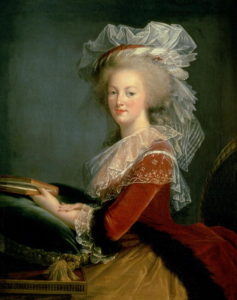What a lively and intelligent-looking beauty was the painter Elisabeth Vigée Le Brun. And what a dull and charmless-looking woman was her patron, Queen Marie Antoinette. It’s one of the first of many surprises in the Metropolitan Museum’s show devoted to the rarely exhibited Vigée Le Brun, who rose from humble beginnings to become one of the most sought-after and highly paid portrait painters of her age.
The two women were born only months apart in 1755. When they were both 23, Vigée Le Brun, the daughter of a pastel artist and largely self-taught, was summoned to Versailles to paint the queen’s portrait. It was the big break of her career.

Élisabeth Louise Vigée Le Brun: Self-Portrait, 1790
The movies may have given us a queen who was pretty and vivacious, but Vigée Le Brun contributed nothing to this myth. In the large painting at the start of this show, she didn’t prettify the queen’s long face, thick nose and drooping Habsburg lip. Nor was Marie Antoinette’s appearance rescued (to our eyes at least) by the absurdly stiff, voluminous gown and towering bird’s nest of a hairdo.
But the picture, a gift for the queen’s mother, was well received in its day and Vigée Le Brun went on to paint some 30 portraits of her illustrious age mate. One of the most charming depicts the queen in simple straw hat and white muslin chemise dress, a popular style in the queen’s court. But the painting ignited a scandal and the artist was forced to do a second, more formal portrait in identical pose. The two are exhibited side by side here for the first time.
Vigée Le Brun’s 1787 portrait, “Marie Antoinette and Her Children” – a centerpiece of this show — was a publicity piece designed to depict the now-unpopular, and allegedly frivolous and extravagant queen as a devout and dignified mother.
It was too late, however. Within two years, the queen and her husband, Louis XVI, were prisoners of the Revolution. Vigée Le Brun, also in danger of arrest and possible execution because of her association with the royal family, left her art-dealer husband behind and fled with her 9-year-old daughter to Italy in 1789.

Marie Antoinette remained a prisoner and was guillotined in 1793. But fortune shone on Vigée Le Brun, who prospered in exile, traveling across Europe for 12 years as a peripatetic portraitist, painting the wealthiest and most glamourous women in Italy, the Hapsburg Empire, Germany and Russia. She returned to France during the reign of Napoleon, enjoyed the adoration of contemporaries, wrote her memoirs, continued to paint, and lived well into the middle of the 19th century, dying at age 87.
The Metropolitan presents some 80 works. The show’s signature image is a 1790 self-portrait that Vigée Le Brun did at the outset of her exile. It was done for the famous collection of self-portraits at the Uffizi gallery in Florence. She is at her easel, dressed in black with a white neck ruff and head scarf, elements reminiscent of paintings by Rembrandt and other Dutch painters. But instead of rendering herself as a somber master, she plays up her own girlish charm and loveliness – beauty and brilliance going hand in hand, the artist as her own most perfect subject.
The painting was a sensation. Vigée Le Brun went on to make a career in which she amplified and redefined feminine allure. In doing so, she built on that rustic informality popularized by Marie Antoinette. Historians may ridicule the queen’s faux peasant poses. (She even had a little farm and cottage built at Versailles where she could play at the role of shepherdess and milkmaid).
But removed from the highly charged political context of the French Revolution, the style became merely a style, part of that eternal game in which women, borrowing from other cultures or across classes, find new ways to capture attention. In portrait after portrait, Vigée Le Brun played with that naturalness so that her subjects – countesses, baronesses, courtesans and mistresses — always seem to be showing a more private self. The means are not always so subtle. This is a show of doe-eyed expressions, rosebud lips, exposed shoulders and heaving bosoms.
Instead of formal hairdos, these women mostly wear a simple hairband so that curls (they all seem to have abundant curls) spill down over their foreheads and around their necks. Some are erotically alluring, such as Hyacinthe Gabrielle Roland, the mistress of Lord Richard Wellesley, who gathers her flowing locks over her bosom and looks to be standing on a windblown heath.
Others were painted as allegorical figures or goddesses, such as the radiant Princess von und zu Liechtenstein, who is painted as the innocent Iris, goddess of the rainbow.
In the hands of a lesser artist, these paintings may have descended to the level of kitsch. But Vigée Le Brun’s talent, like the beauty of her subjects, has an irresistible magnetism, giving her paintings the timeless touch of art.

